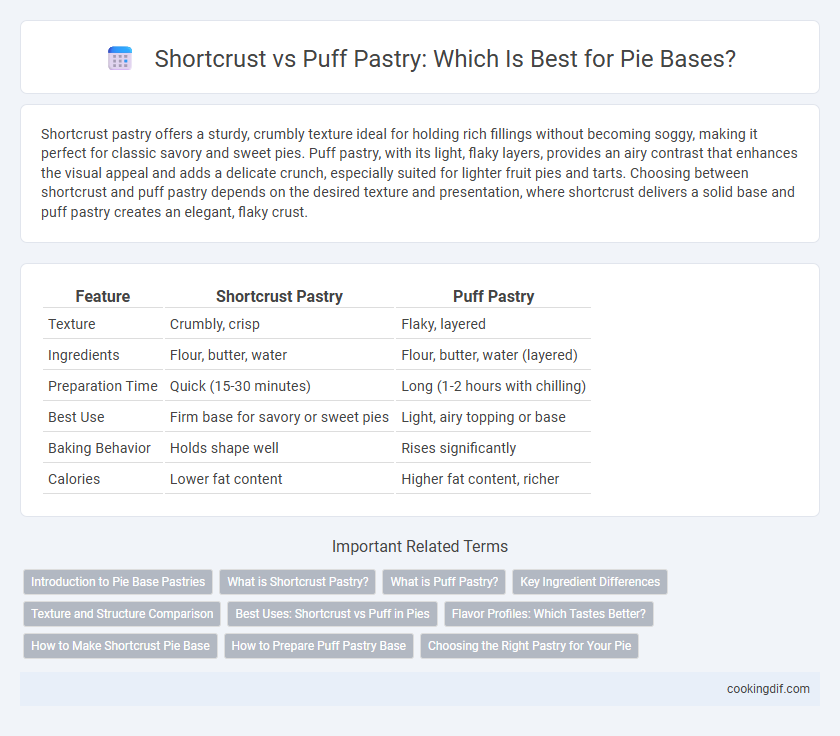Shortcrust pastry offers a sturdy, crumbly texture ideal for holding rich fillings without becoming soggy, making it perfect for classic savory and sweet pies. Puff pastry, with its light, flaky layers, provides an airy contrast that enhances the visual appeal and adds a delicate crunch, especially suited for lighter fruit pies and tarts. Choosing between shortcrust and puff pastry depends on the desired texture and presentation, where shortcrust delivers a solid base and puff pastry creates an elegant, flaky crust.
Table of Comparison
| Feature | Shortcrust Pastry | Puff Pastry |
|---|---|---|
| Texture | Crumbly, crisp | Flaky, layered |
| Ingredients | Flour, butter, water | Flour, butter, water (layered) |
| Preparation Time | Quick (15-30 minutes) | Long (1-2 hours with chilling) |
| Best Use | Firm base for savory or sweet pies | Light, airy topping or base |
| Baking Behavior | Holds shape well | Rises significantly |
| Calories | Lower fat content | Higher fat content, richer |
Introduction to Pie Base Pastries
Shortcrust pastry, known for its crumbly and tender texture, provides a sturdy and buttery base ideal for both sweet and savory pies. Puff pastry features multiple layers of flaky, airy dough created by folding butter into the dough repeatedly, resulting in a light and crisp crust that rises when baked. Choosing between shortcrust and puff pastry depends on the desired texture and appearance of the pie base, with shortcrust offering solidity and puff pastry delivering a delicate, flaky finish.
What is Shortcrust Pastry?
Shortcrust pastry is a classic pie base known for its tender, crumbly texture achieved by combining flour, fat, and minimal water without yeast. It provides a sturdy yet flaky foundation ideal for both sweet and savory pies, ensuring the filling remains intact without becoming soggy. Unlike puff pastry, shortcrust lacks layers but offers a rich, buttery flavor that enhances the overall pie experience.
What is Puff Pastry?
Puff pastry is a light, flaky dough made by repeatedly folding and rolling layers of butter into the dough, creating hundreds of thin layers that rise and separate during baking. Its high butter content and meticulous lamination process result in a crisp, airy texture ideal for both sweet and savory pies. Unlike shortcrust, puff pastry provides a delicate crunch and puffed appearance, enhancing the overall presentation and mouthfeel of pie bases.
Key Ingredient Differences
Shortcrust pastry relies on cold butter and minimal water to create a crumbly, tender base essential for sturdy pie crusts, while puff pastry requires multiple folds of butter and dough to achieve its signature flaky layers. The high butter content and repeated folding in puff pastry produce steam during baking, causing the dough to rise and separate into delicate, airy layers. Shortcrust's key ingredient ratio emphasizes firmness and structure, whereas puff pastry's technique and butter distribution prioritize lightness and flakiness.
Texture and Structure Comparison
Shortcrust pastry offers a firm, crumbly texture that provides a sturdy base ideal for heavier pie fillings, maintaining structural integrity without becoming soggy. Puff pastry, with its multiple flaky layers created by repeated folding and butter incorporation, delivers a light, airy texture that rises and crisps during baking, offering a delicate contrast to the filling. The denser composition of shortcrust ensures durability, while puff pastry's laminated structure prioritizes flakiness and tenderness, making each suitable for different pie types based on desired mouthfeel and filling weight.
Best Uses: Shortcrust vs Puff in Pies
Shortcrust pastry offers a sturdy, crumbly base ideal for savory and sweet pies that require a firm structure, such as quiches and fruit tarts. Puff pastry, with its light, flaky layers, is best suited for delicate or rich fillings, adding a buttery texture to chicken pot pies or apple turnovers. Choosing between shortcrust and puff pastry depends on the pie's filling consistency and desired crust texture for optimal flavor and presentation.
Flavor Profiles: Which Tastes Better?
Shortcrust pastry offers a rich, buttery flavor with a tender, crumbly texture that complements savory and sweet pie fillings, creating a balanced taste experience. Puff pastry provides a light, flaky, and airy texture with a subtly buttery taste, adding a delicate crispness that enhances the overall mouthfeel. Flavor preference depends on the pie's filling; shortcrust suits denser, hearty ingredients, while puff pastry excels with lighter, fruit-based pies.
How to Make Shortcrust Pie Base
To make a shortcrust pie base, combine cold, cubed butter with flour and a pinch of salt, rubbing the butter into the flour until the mixture resembles breadcrumbs. Add cold water gradually, mixing gently to form a dough without overworking it, ensuring a tender, crumbly texture ideal for pie crusts. Chill the dough before rolling out to prevent shrinking and achieve a crisp, buttery shortcrust base distinct from the flaky layers of puff pastry.
How to Prepare Puff Pastry Base
Preparing a puff pastry base for pies involves working with chilled dough to maintain its many delicate layers that create a flaky texture when baked. Roll the puff pastry gently on a lightly floured surface to the desired thickness, then carefully transfer it to the pie dish without stretching to preserve the rise during baking. Docking the base with a fork prevents excessive puffing, ensuring an even crust that supports the pie filling effectively.
Choosing the Right Pastry for Your Pie
Shortcrust pastry offers a crumbly, buttery texture ideal for savory and fruit pies that require a sturdy base to hold fillings without sogginess. Puff pastry provides a light, flaky, and layered structure, perfect for pies needing an elegant, crispy top or a delicate, airy base. Selecting the right pastry depends on the desired texture and filling stability, with shortcrust excelled for dense, hearty pies and puff pastry favored for lighter, visually impressive desserts.
Shortcrust vs Puff for pie bases Infographic

 cookingdif.com
cookingdif.com